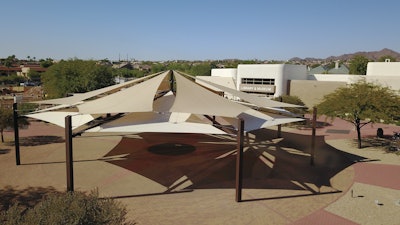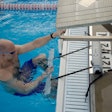
Research from the Skin Cancer Foundation estimates that one in five Americans will be diagnosed with skin cancer by the age of 70. With the leading cause of this common cancer being the sun’s ultraviolet rays, there is no time like the present for facilities to address their shade structure needs.
JJ Orlando, director of business development at Shade ’n Net has seen firsthand how the rising rate of skin cancer has impacted people’s desire for shade. Gone are the days of sun berms and all-day-long sun exposure. Now, shade is a key amenity, whether at the pool, the ballpark or the pickleball court.
Orlando knows that the need for shade goes beyond health risks. “With all the talk about the ozone layer and global warming, whether you buy into it or not, getting the sun beating down on you is just not favorable these days,” Orlando says.
Her qualitative observations are backed up by research from the National Institutes of Health, which reported that increasing global temperatures and corresponding ozone depletion could increase the number of skin cancer cases by 5,000 to 6,000 per year by 2050. The bottom line: shade is now more important than ever.
The race for shade is happening everywhere, as DynaDome’s Cihan Ozdemir, vice president of sales, can attest. “The southern states like Arizona, Texas, Nevada, New Mexico, they’re looking for that escape from the sun,” Ozdemir says, adding of his company’s retractable enclosure product, “They use it as a shade structure for their aquatics.”
However, shade applications stretch well beyond the pool deck to fields and courts. Says Orlando, “People want to have that outdoor experience and utilize that space.”
Leaders at Shade ’n Net, Anchor and DynaDome spoke with AB about the need for shade structures, including turnkey solutions, fabric sails, fully customizable steel structures and umbrellas at various facility types — and the societal trends driving the shade boom.

Aquatics
The pool is the classic facility that is ripe for shade structures. While some patrons dive into the water to cool down, work out or recreate, those on the pool deck rely on shade to stay cool and comfortable all day long.
Whether it’s a competitive venue, a water park or a community aquatics complex, a robust mixture of shade structures can be found at all of them.
“Shade usually comes at a premium,” says Kevin Post, CEO of Counsilman-Hunsaker. “You’ll see basic shade canopies, but also rentable cabanas.”
The team at Counsilman-Hunsaker worked as the aquatic design consultants for Columbine West Park and Pool Foothills Park and Recreation District in Littleton, Colo. Along with the architects at Perkins&Will, they worked to bring shade to the pool deck.
“At Columbine, there was a real emphasis on adding more shade,” Mira Theisen, associate principal at Perkins&Will says. “We did really deep overhangs on the building to allow more shade for people.”
The team at Columbine also wanted rentable cabanas and updated picnic shelters on the pool deck to add even more shade for patrons. “The biggest thing that is becoming more common is shade. In the ’90s, we would have built a big sunning berm, trying to get all the sun we can,” says Post. “Now, if you want to spend the day outside, you’ll want more shade.”
Another outdoor pool in Greenville, S.C., took a different approach to managing the effects of the sun. The YMCA of Greenville initially contacted DynaDome to cover their outdoor pool so it could be used year-round.
“What we saw is actually during the summer, we can close it and take advantage of the partial shade to keep the water cool and our members cool, too,” says John Schlansker, vice president of facilities and risk management at YMCA of Greenville. “It’s hot down here in South Carolina, so to have those options in the summer months is something that we didn’t even plan for, but is a huge benefit.”
Ozdemir says the team at the YMCA of Greenville isn’t the first to realize the unexpected shade benefits of a DynaDome structure. “People have their own ideas in their minds: ‘When it’s summer, we’re going to open it all the way up, and we’re going to keep it open,’ ” says Ozdemir. “No, you’re not. No matter how much you love that sun, and your members love the sun, you’ll always still be looking for places to escape.”
DynaDome structures allow for natural sunlight and airflow, and the roof opens and closes with the push of a button, allowing facilities to cover outdoor pools when the weather calls for it, but open the roof when the sun is shining. “You can seat several people here who want to get away from the sun and get in the shade,” Ozdemir explains.
From the shade manufacturer’s perspective, there is no shortage of options for providing shade to aquatic facilities of all kinds. “On pool decks, we’ve covered pools with a sail structure that covers one end of the pool or even spans across the entire pool, depending on what they want to do,” says Orlando. “We’ve done cantilevered structures around seating areas or splash pads.”
Orlando also describes a windmill design for fabric shade structures covering splash pads, where water runoff is a key concern. In those cases, the team at Shade ’n Net has built a multi-panel structure that covers large areas of the splash pad from the direct sunlight while it guides water runoff away from the splash pad and out to the edges.

Pickleball
If aquatics is the old school use for shade applications, then pickleball is the new kid on the block. Even court sport athletes deserve a break from the sun, and Anchor general manager Phil St. Germain says this market is really picking up.
“Pickleball is just exploding all over the country and shade is necessary at those locations,” says St. Germain. “We’ve been doing a lot with pickleball courts.”
Whether approaching a project for a community parks and rec department or large-scale pickleball facilities such as Chicken N Pickle in cities across the country, there are myriad ways to provide shade for the burgeoning sport.
Recreational games of pickleball last an average of 30 minutes, leaving players without sun protection to face a significant risk of sunburn, heat exhaustion and dehydration. With the addition of a simple shade structure, players can enjoy a substantial difference in temperatures. Orlando notes that in most cases, the temperature under a shade structure is 30 degrees cooler than it is out in the sun, and there are several options for achieving this cooler shade.
“With pickleball, we can cover the whole court, or we can do shade for spectators along the side,” St. Germain says. “Another install we’ve done is umbrellas in the middle, between courts. So, we’ve done all three in the past couple of years. That is definitely a new trend we’re seeing.”

Sports fields
Another recent addition to the shade structure market is sports fields. From baseball to football, outdoor sports complexes — especially those that host multiday youth tournaments — have a need for shade. Says Anchor’s St. Germain, “What we’ve been seeing in the past few years is a big increase at sports facilities.”
The same is true at Shade ’n Net. “People use them a ton for dugouts or areas for the teams to sit, but also, obviously, for people to watch sports,” says Orlando, noting that Shade ’n Net’s fabric structures are popular for these applications, because traditional metal-roofed shade structures can actually increase the temperature in and around bleachers and dugouts.
Right down the road from Anchor’s headquarters in Evansville, Ind., the Deaconess Sports Park is home to 18 individual ballfields and soccer fields, and it spans dozens of acres. It is a shining example of how shade can be utilized to keep patrons and players safe and happy. “They covered all their bleachers with our shades. They put a ton of shade out there, and a big reason was because they host tournaments,” says St. Germain. “Shade is a thing that is needed when you’re outside, sitting in the summertime, all day long, watching your kids for five hours.”
The impact that a lack of shade can have is obvious. “Another client said that the number one complaint they have at their parks is that there’s not enough shade,” St. Germain says.
Everybody wants more shade. While the products that Orlando, St. Germain and Ozdemir promote are mechanically very different, they have a similar end goal: to protect patrons from the sun and give them an ideal outdoor environment.
The process of creating the various shade solutions shared by Anchor, Shade ’n Net and DynaDome, however, could not be more different.
While some companies prefer to step back from the installation process, others take a hands-on approach. Anchor, for example, “really only involves [themselves] in the ordering process, and then when it ships, the installation is on the purchaser,” says St. Germain. “We sell to contractors and construction companies, as well as end users. We call them turnkey, because you can get it done with two or three people.”
Meanwhile, at Shade ’n Net, the entire process is handled in-house. Its team is involved from pitch and permit to manufacturing and installation. “We’ll go out and look at the area that they want, see what times of the day that they want to utilize the shade and what they’re using it for, so we can recommend what works, what height, what size,” says Orlando. “Installation, they dig footings, they set cages. They have city inspections on those footings to make sure that everything matches the drawings. And then they pour concrete. We put in our templates and our J bolts, then we let the concrete cure, and we bring in the structure a couple of days later.”
The team at DynaDome goes through a similarly involved process, with the Greenville YMCA describing a months-long schedule to plan, design, manufacture and assemble the fully customizable structure.
“Everybody likes to be outdoors when it’s nice out,” says Ozedmir. “But then still being able to be protected from the sun, from the glare and things like that, is important.”

Shade that generates revenue
Common at many of today’s cutting-edge facilities are advertiser logos on sections of seating, video boards or beverage containers. All of these branding opportunities, large and small, generate revenue and reduce costs for the facility. The same options could be available for shade.
Choosing a shade solution can be a significant financial commitment for any facility, but Phil St. Germain, general manager at Anchor, explains that the cost burden can be reduced or, in some cases, totally eliminated through sponsorships.
For some of Anchor’s products, the company can print graphic logos onto the umbrella panels.
“For example, at Six Flags, they will have these around their eating venues,” says St. Germain. “Coca-Cola buys all these tops for Six Flags, and then we print Coca-Cola and Sprite on the panels.”
While amusement parks represent a big player in a small portion of the market, this opportunity is also available in any local park. “The parks and rec department isn’t having to purchase the shade for their splash pad or pickleball courts if they can find a partner to advertise on the product and sponsor it,” says St. Germain. This way, the advertiser covers the cost of the product and generates revenue for the park or facility.
“If you have a pickleball court going up in a town, and a big company that is headquartered there wants to sponsor the shade at that location, they can put their logo and graphics on it,” St. Germain says. “These tops last for an average of seven years, so it is a relatively small investment for an organization to brand and have that advertising in their community.”
























